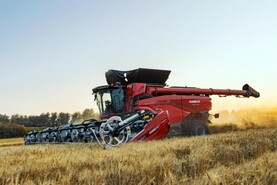The slurry that went out well over a fortnight ago is sitting on the fields after the silage – dried out and solid. I assume that any nitrogen is well gone by this stage but that when the rain comes the phosphorous and potassium will hopefully be washed down. The fields themselves, after almost three weeks’ cut, have a dull green sheen on them from a distance but up close there is nothing there.
The silage is a modest heap in the corner of the pit. I sold all of my reserves of silage, over 400t, to one of the co-ops during the spring but of course I am now wondering if I was too quick to deplete my stocks.
In the grazing paddocks, the dung pats are sitting on the ground like the decomposed elephant droppings you would see in an African nature film.
There is no sign of any worm activity. The young bulls are however remarkable contented as they fill themselves up on the fresh grass – it is really too strong for grazing but it has to be used and they have a generous run back where they can pick on the leftovers from earlier days in the week.
But this contentment is critically dependent on water. So far, we have had no problem with our deep well, but we have become obsessed to ensure there are no leaks anywhere in the system and that our large tank is ready to act as a temporary reservoir. But, as mentioned last week, the main fall back is my spring that has never failed and is still flowing away.
Winter barley harvest
Meanwhile, on the tillage side, we are preparing for the winter barley harvest. The combine is due to arrive midweek and I expect to be harvesting sometime before or during the weekend. What the yields of straw and grain are likely to be is difficult to say. The beans are in full flower but seem much shorter than usual, while the oilseed rape and oats are rapidly turning, and even the wheat is maturing.
Read more
Dempsey at Large: two open days on beef and tillage
The slurry that went out well over a fortnight ago is sitting on the fields after the silage – dried out and solid. I assume that any nitrogen is well gone by this stage but that when the rain comes the phosphorous and potassium will hopefully be washed down. The fields themselves, after almost three weeks’ cut, have a dull green sheen on them from a distance but up close there is nothing there.
The silage is a modest heap in the corner of the pit. I sold all of my reserves of silage, over 400t, to one of the co-ops during the spring but of course I am now wondering if I was too quick to deplete my stocks.
In the grazing paddocks, the dung pats are sitting on the ground like the decomposed elephant droppings you would see in an African nature film.
There is no sign of any worm activity. The young bulls are however remarkable contented as they fill themselves up on the fresh grass – it is really too strong for grazing but it has to be used and they have a generous run back where they can pick on the leftovers from earlier days in the week.
But this contentment is critically dependent on water. So far, we have had no problem with our deep well, but we have become obsessed to ensure there are no leaks anywhere in the system and that our large tank is ready to act as a temporary reservoir. But, as mentioned last week, the main fall back is my spring that has never failed and is still flowing away.
Winter barley harvest
Meanwhile, on the tillage side, we are preparing for the winter barley harvest. The combine is due to arrive midweek and I expect to be harvesting sometime before or during the weekend. What the yields of straw and grain are likely to be is difficult to say. The beans are in full flower but seem much shorter than usual, while the oilseed rape and oats are rapidly turning, and even the wheat is maturing.
Read more
Dempsey at Large: two open days on beef and tillage






 This is a subscriber-only article
This is a subscriber-only article









SHARING OPTIONS: